We are big fans of applying a light coat of natural carnauba-style car wax to our metal garden furniture after it has been washed and dried.
You don’t need much. Just a small amount on a microfibre cloth goes a long way. It gives the paintwork a lovely lustre, leaves no residue, absorbs into the paintwork, helps moisture bead on the surface, and reduces the need to clean it as often.

We looked at the reasons why we like to apply it and how best to apply it in detail in our How to apply car wax to our metal garden furniture article, so in this post, we want to look at the other popular outdoor furniture materials on sale in the UK and ask if it is best to wax, oil, re-paint, stain, or varnish them?
The best finishing method, much like cleaning, depends on the type of material your furniture is made from, the desired finish you want, and the level of protection required.
1. Iron Garden Furniture
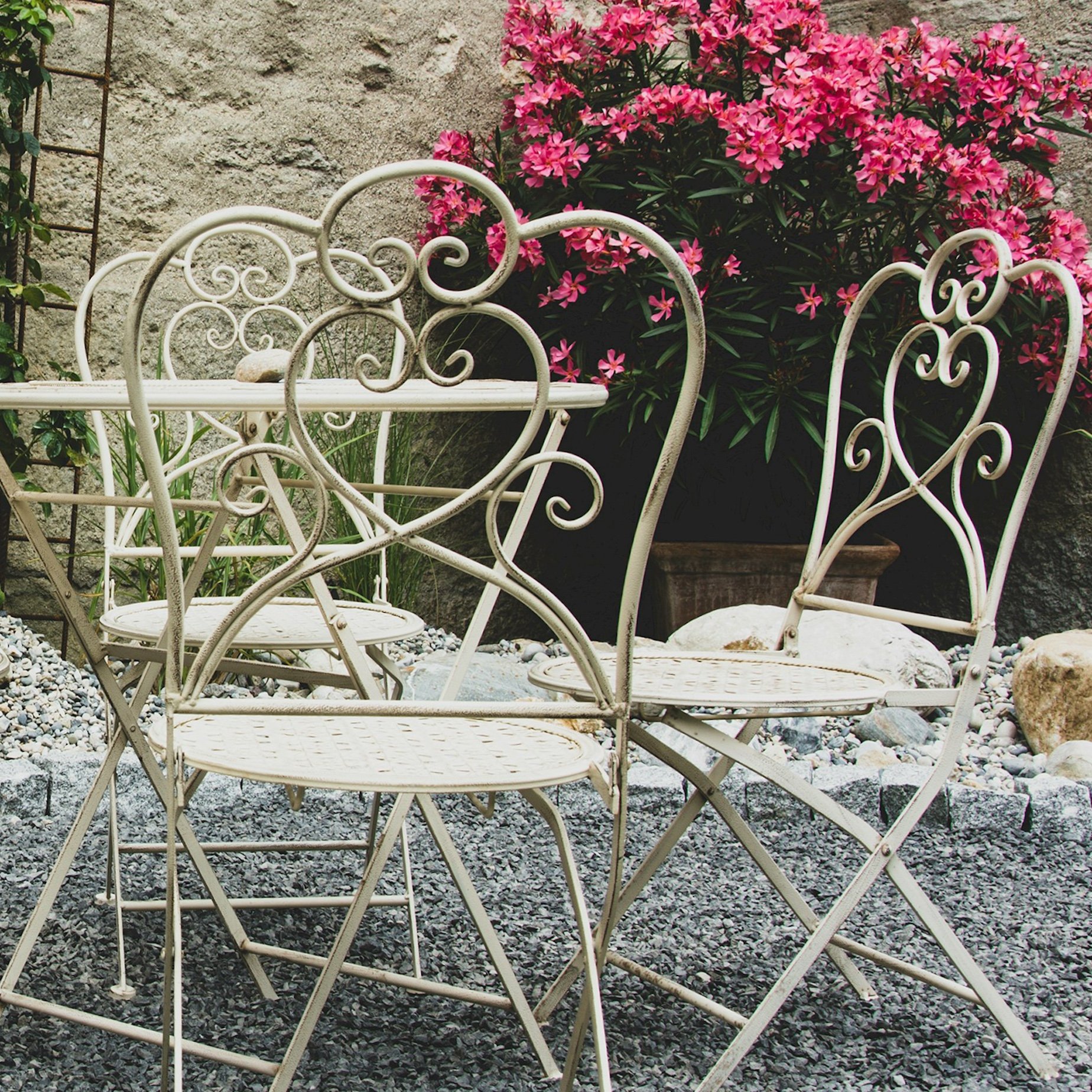
When it comes to cast or wrought iron garden furniture, in our opinion, you should not apply any wax or oil. Cast iron might use a similar production method to cast aluminium but they are very different metals, and we discussed this recently in our Is cast aluminium better than cast iron? article.
Iron, both in cast (molten and poured into moulds) and wrought (worked into shape with heat and tools), is highly susceptible to rust. To keep it resistant to the elements and thus oxidation, it requires a painted finish (often a primer and topcoat or a 2-in-1 paint) to prevent it from corroding.
Some cast iron on sale in the UK is powder-coated though, so make sure you know how your furniture is finished and follow the manufacturer or retailer's guidance for care and maintenance.
However, due to iron’s susceptibility to rust, we would avoid applying any waxes or oils to finish as it could trap moisture and potentially penetrate the painted finish, speeding up the rusting process.
The cast aluminium we use for our metal garden furniture range is protected with a durable powder-coated finish. Aluminium is a naturally anti-corrosive metal too, so for our range, this is not an issue.
The best way to maintain and protect both cast and wrought iron garden furniture is to clean the furniture regularly with warm soapy to remove dirt/dust and allow the furniture to dry completely to prevent rust from forming.
If you do find any rust, tackle it immediately with a rust converter to convert it into a more stable oxide layer and repaint to protect it.
You can also repaint iron furniture if it is looking a little tired. Opt for a high-quality exterior metal paint that can withstand weather conditions in the UK and make sure to prep correctly, tackle any rust spots, and apply a primer first.
The best way to protect and reduce the need to maintain is to store it in bad weather, cover it to keep it dry and regularly inspect the paintwork to see if it needs retouching.
Only use high-quality, rust-resistant paint specifically designed for outdoor use or products the manufacturer recommends.
2. Stainless Steel Garden Furniture
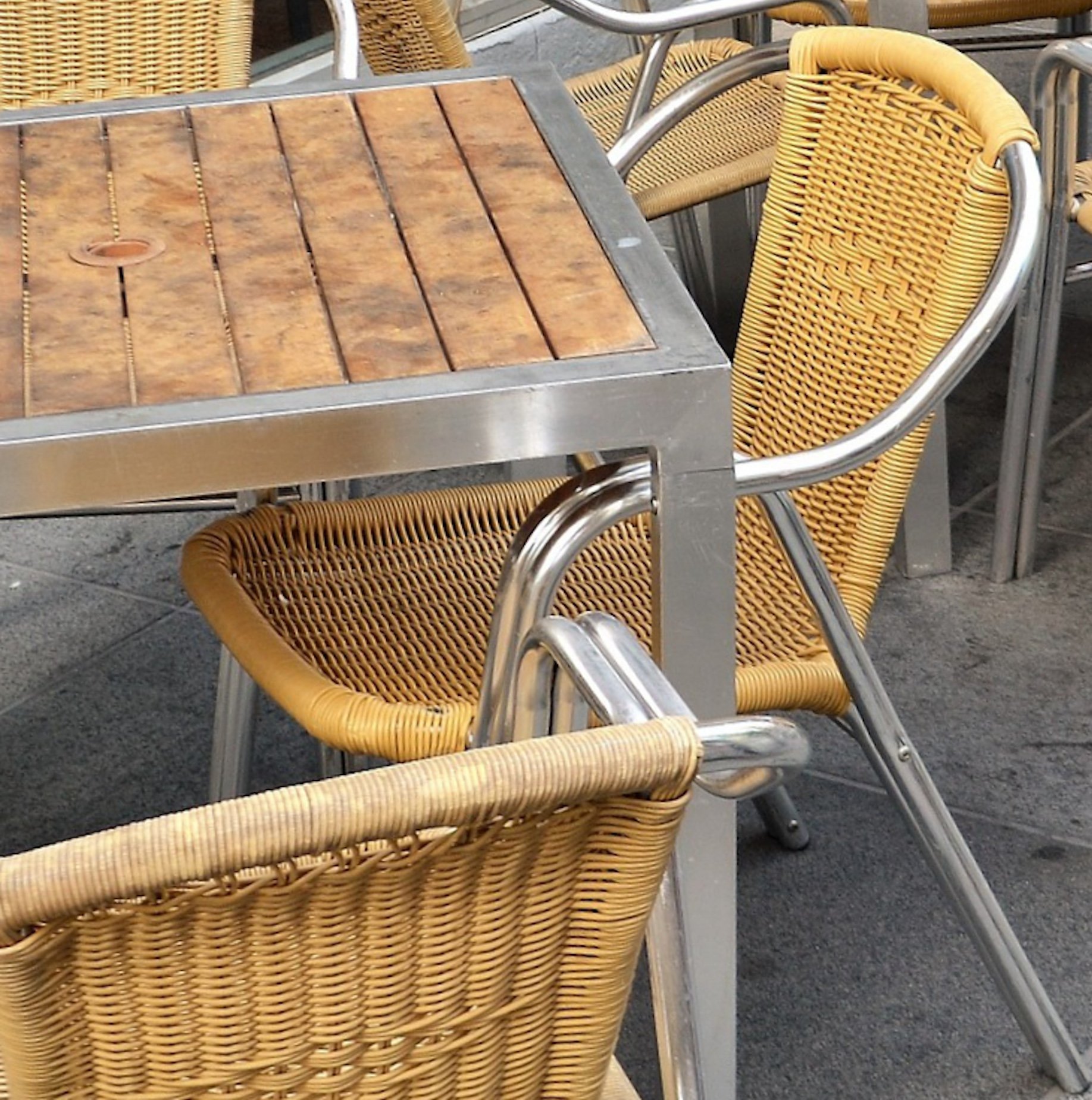
Steel is another popular metal, and due to its high iron content, it is also highly susceptible to rust. However, in the UK, much of the modern garden furniture sold is made from stainless steel, whereby the steel is coated with chromium, which reacts with the oxygen and moisture in the air to produce a microscopic layer that protects the underlying metal.
While neither waxing nor oiling is strictly necessary for stainless steel garden furniture, if applied correctly, it can offer some benefits. Much as with cast aluminium, a light coat of car wax will enhance the lustre and repel water. It creates a temporary barrier that makes stainless steel look shinier and cleaning easier.
Another good option for stainless steel is to apply baby oil or food-grade mineral oil with a lint-free cloth. Again, you don’t need much, just a light coat to not make the surface greasy.
Stainless steel patio furniture is notorious for showing watermarks and fingerprints, so oiling is a great way to reduce this and give the surface a nice even finish after washing.
The downside of oiling metals is that they need regular re-application. Car wax will too but it lasts much longer and it doesn’t seem to attract dust and dirt as quickly as oils.
Some manufacturers advise against using wax on certain stainless steel finishes, so always check your specific furniture. They might advise against using any wax or oil, or recommend specific products that work best with their finish.
If you primarily want to enhance the shine and water repellency and are willing to reapply regularly, then we have found car wax to be suitable. If you want a light protective layer and are looking for a more natural finish, then food-grade mineral oil is the better option.
Ultimately, the decision of whether to wax or oil your stainless steel garden furniture is up to you. Both have pros and cons, however, if you are unsure, then our advice would be to test on the underside of a chair or table first.
3. Rattan Wicker Garden Furniture
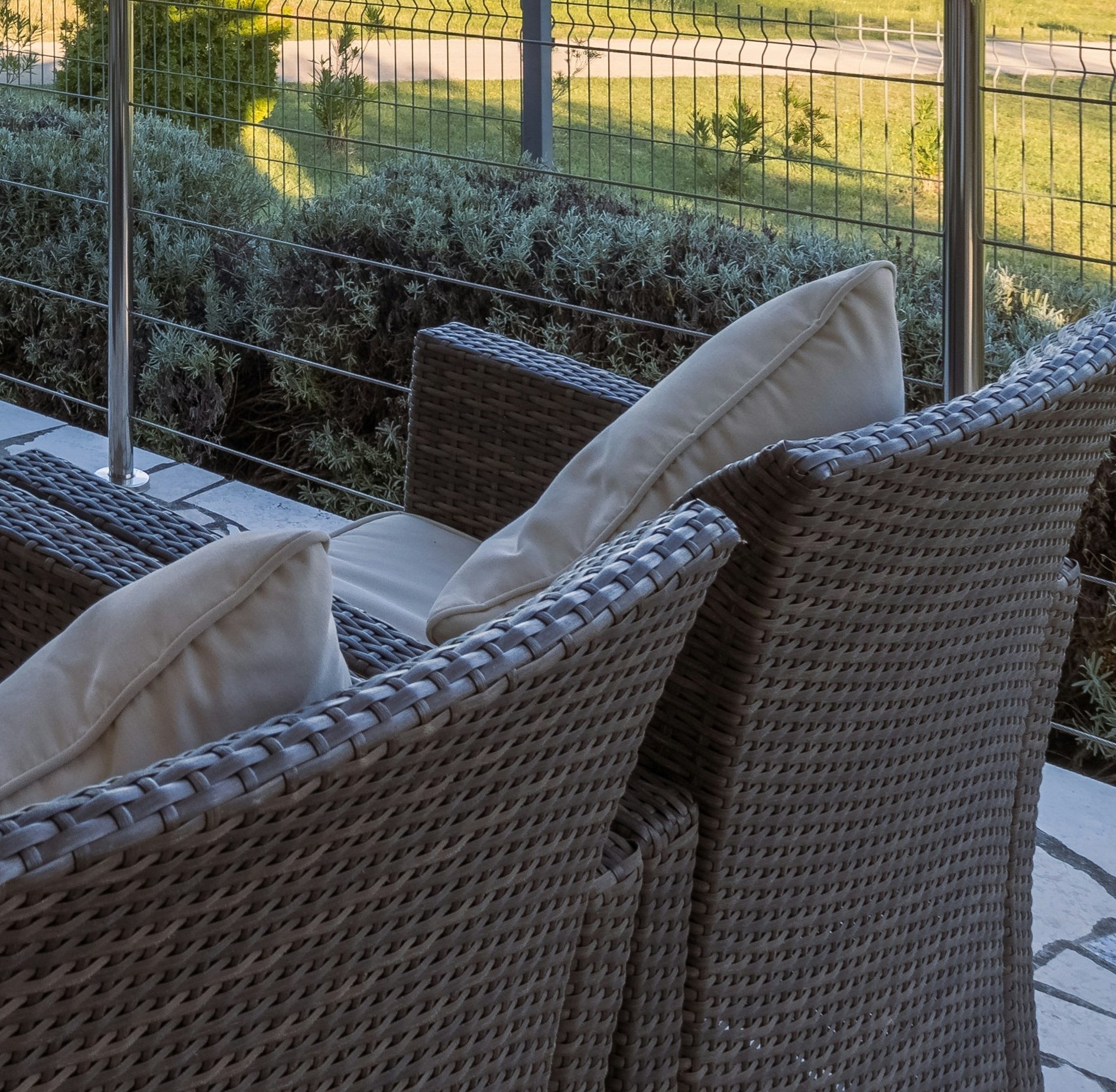
When we talk about rattan wicker furniture, rattan is the material and wicker is a weaving technique. Wicker furniture can be made from natural materials like bamboo, reed, or willow but they’re best suited to indoor use as they are not weather-resistant.
Much of the wicker-style furniture on sale and popular in the UK is made from a synthetic poly-rattan made from plastic resin that can be woven in a wicker style and is much better suited to garden use.
When it comes to the application of a finish after cleaning, then you could apply both wax and oil to poly-rattan furniture to enhance its appearance and provide a little extra protection but we would advise against it.
The plastic resin is already designed to be weather-resistant and UV-protected, making wax or oil unnecessary for additional protection. They are often woven over a powder-coated aluminium frame too, and whilst you can’t see it, it is fully weather-resistant.
If the plastic is looking a little dull, then a light coat of wax or oil can enhance the natural shine and lustre of your furniture, however, in our experience, the biggest issue with poly-rattans is their tendency to fade, split or crack when exposed to the sun.
If the rattan is already damaged then we would advise against applying any furniture waxes or polishes, as they could make the problem worse.
If you do want to try and give it a nice sheen after cleaning, then you could try natural products like carnauba wax, beeswax, linseed oil, or tung oil.
It is important to clean the furniture thoroughly before you apply anything to remove dirt, dust, and debris with a soft brush or a damp cloth with mild soap and water.
If the furniture is dry, then you could also give it a hoover to get any dust from in-between the wicker weave. It must be dry before applying any wax and oil, and test in an inconspicuous area before you tackle the job in full to see the finish.
We have seen people paint old poly-rattan furniture but it is not something we would advise as the results are often a little on the messy side.
You will only need to apply a small amount of the chosen wax or oil with a soft lint-free cloth to see how it goes on and if it gives the desired results. Work in small sections and buff gently with the cloth and avoid getting any build-up between the rattan weave.
4. Plastic Resin Garden Furniture
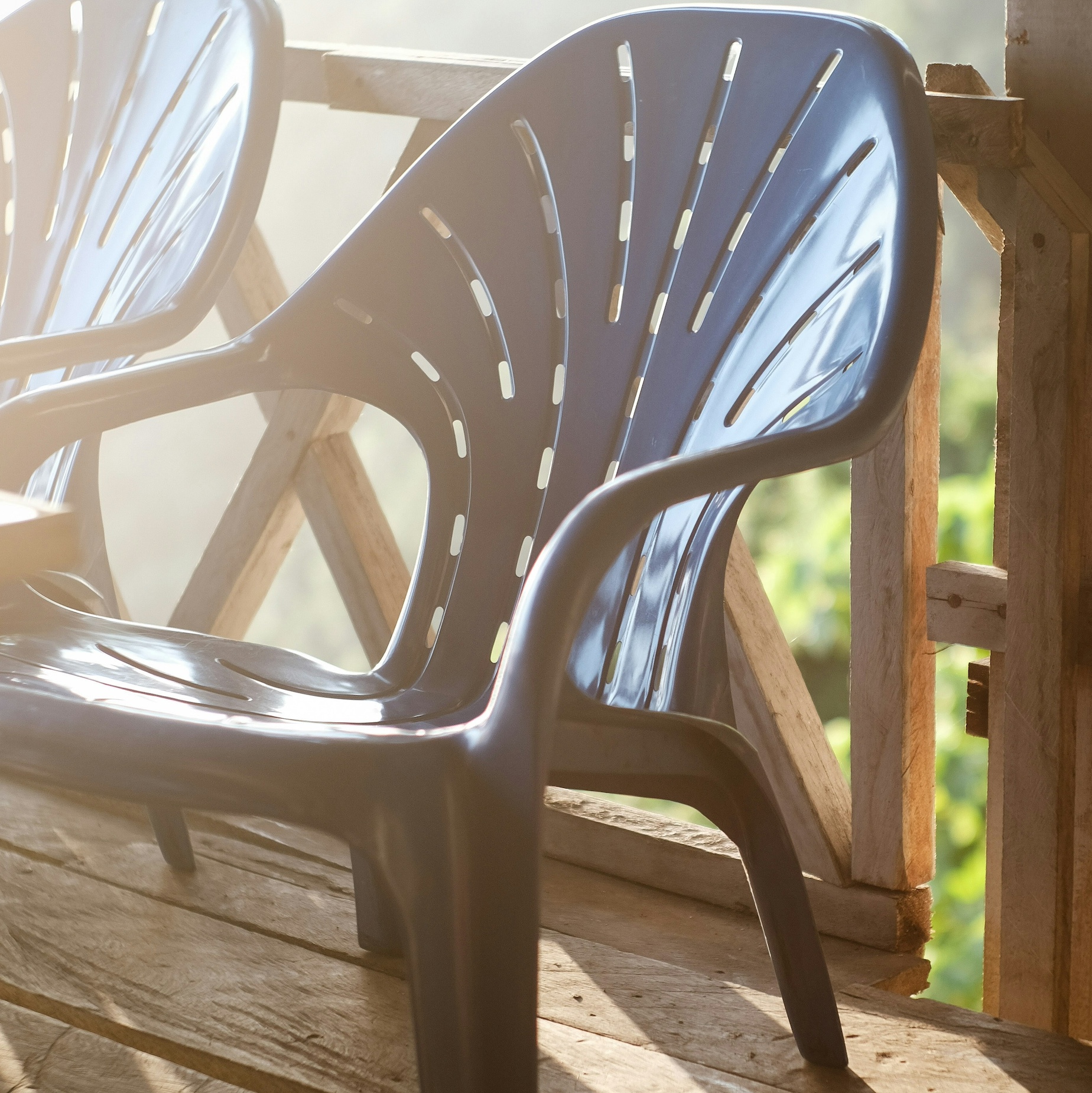
Much like poly-rattan, we would not recommend the application of wax or oil to plastic resin furniture. Certainly not if it is a recent purchase.
Plastic resin is already specially designed to be weather-resistant and UV-protected, making wax or oil unnecessary for additional protection.
Applying wax or oil could even trap moisture underneath, leading to mould forming or even warping of the plastic. It can also leave a greasy residue on smooth plastics that attracts dust and dirt.
If the furniture is a little older and the finish is looking a little dull and weather-beaten, then you could look at applying a natural product such as the aforementioned carnauba wax, beeswax, linseed oil, or tung oil. Again, make sure you test first and apply sparingly.
With plastic garden furniture, regular cleaning with soapy water to remove dirt, dust, and debris is the best way to keep it looking like new.
It can stain easily when left outside so if you have any stubborn stains, a diluted solution of white vinegar and water is a great way of removing them. Avoid using any harsh chemicals or abrasive cleaners as they can damage or dull the finish of the plastic.
If you are concerned about fading due to prolonged sun exposure, consider placing your furniture in shaded areas or using furniture covers when you’re not using them.
If you're looking for a way to enhance the appearance of your plastic resin furniture, then there are a few alternatives to natural oil and wax that we would suggest you test and try.
A specialist furniture polish that’s designed for plastic surfaces is one way you can restore shine and provide a little additional protection or you could apply a vinyl protector that is designed for cars or boats. These products can help prevent cracking and fading while maintaining the original look and finish of the plastic.
Another product we can recommend is Scotchgard’s Heavy Duty Water Shield, as it is easy to apply and it creates a durable barrier that you can’t see or feel but helps water and dirt runoff. Again, just be sure to test on an inconspicuous area (such as the underside of a chair) first.
5. Wooden Garden Furniture
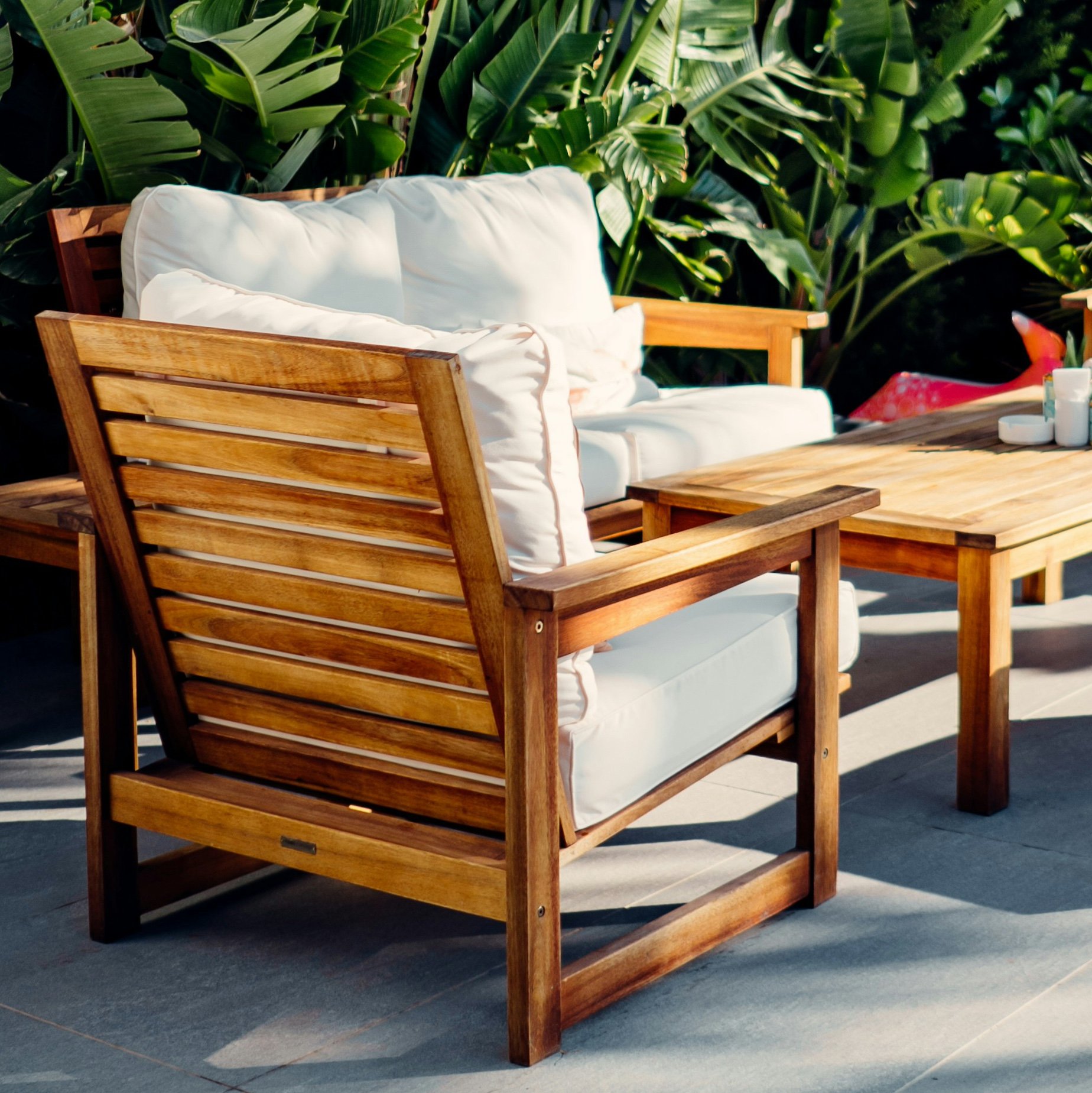
Probably the outdoor furniture material most closely associated with wax and oil is wood, and depending on the type of timber, existing finish, and protection you want, all are suitable.
Applying wax to wooden garden furniture will provide a beautiful natural, low-sheen finish that enhances the wood's natural beauty. It will offer some protection against moisture and minor scratches but it is not as tough as say varnish.
Oils will penetrate the wood, nourishing and protecting it from within. It enhances the wood's natural colour and grain, giving it a warm, rich appearance. In our opinion, it is probably the easiest finish to apply, and whilst offering better protection than wax, it is not as durable as varnish.
Varnish forms a hard, protective coating on the surface of the wood, providing excellent durability and resistance to moisture, UV rays, and scratches. It can be applied in a variety of colours (if you want to change completely), and sheens from matte to high gloss, so you can achieve the desired look you like
On the flip side, it tends to give a more plastic-looking finish compared to wax or oil (but again this is just our opinion), and it is the most time-consuming and messy to apply. Also, make sure you remove any fabric cushions before you apply wax or oil as they could stain the material.
Painting wood is a great way to revive old furniture, change up the look of your outdoor space, or protect the wood from the elements. Preparation is key when painting, you want it clean and sanded down so you have a nice smooth surface for the paint to adhere to. Start with a primer specifically designed for exterior wood and choose a high-quality exterior wood paint that can withstand the sun and rain.
Ultimately, the best choice for finishing wooden garden furniture depends on your priorities and preferences. If you prefer a natural, rustic look and don't mind more frequent maintenance, wax or oil finishes are best. However, if you prioritise durability and long-term protection, then varnishing is the better option.
If your furniture is made from mixed materials, such as wood and metal for example, then you must clean each material carefully and correctly.
Regarding the Lazy Susan range, our How to Apply Car Wax to Metal Garden Furniture article should be your next port of call.
If you have any photos of your new metal garden furniture from Lazy Susan, we’d love to see a few for our Do Some Good charity campaign. You can tag us @LazySusanFurniture on Instagram or Facebook or Upload Here.



